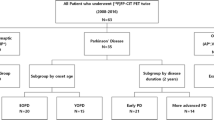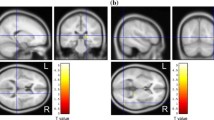Abstract
Purpose
Single-photon emission computed tomography (SPECT) with [123I]FP-CIT is a marker for loss of presynaptic dopamine transporters in the striatum in Parkinson’s disease (PD). We used [123I]FP-CIT SPECT in order to evaluate binding to the dopamine transporter before and after neurosurgical treatment with bilateral stimulation in the subthalamic nucleus (STN).
Methods
Thirty-five patients with levodopa-responsive PD were examined with [123I]FP-CIT SPECT pre-operatively (baseline scan: mean 3 months before surgery), and 3 and 12 months after surgery.
Results
Pre-operatively, all patients already had substantial signs of severe nigrostriatal neuronal loss as determined from the [123I]FP-CIT SPECT scans. One year after surgery the specific [123I]FP-CIT binding to the striatum was significantly reduced by 10.3% compared with the pre-operative baseline scan. The mean time span from the baseline scan before surgery to the follow-up scan 1 year after surgery was 16.2 months. Hence, the rate of reduction equals a mean annual reduction of 7.7%. A comparable control group of patients with PD who did not undergo surgery was also examined longitudinally. In this group the specific binding of [123I]FP-CIT was reduced by 6.7% per year.
Conclusion
The specific binding of [123I]FP-CIT was reduced equally in the STN-stimulated patients and a group of non-operated PD patients with advanced disease. Our study does not support the notion that electrode implantation and STN stimulation exert a neuroprotective effect by themselves.





Similar content being viewed by others
References
Kumar R, Lozano AM, Hutchison WD, Sime E, Halket E, Lang AE. Double-blind evaluation of subthalamic nucleus deep brain stimulation in advanced Parkinson’s disease. Neurology 1998;51(3):850–5.
Limousin P, Krack P, Pollak P, Benazzouz A, Ardouin C, Hoffmann D, et al. Electrical stimulation of the subthalamic nucleus in advanced Parkinson’s disease. N Engl J Med 1998;339(16):1105–11.
Moro E, Scerrati M, Romito LMA, Roselli R, Tonali P, Albanese A. Chronic subthalamic nucleus stimulation reduces medication requirements in Parkinson’s disease. Neurology 1999;53:85–90.
Valldeoriola F, Pilleri M, Tolosa E, Molinuevo JL, Rumia J, Ferrer E. Bilateral subthalamic stimulation monotherapy in advanced Parkinson’s disease: long-term follow-up of patients. Mov Disord 2002;17(1):125–32.
Pinter MM, Alesch F, Murg M, Seiwald M, Helscher RJ, Binder H. Deep brain stimulation of the subthalamic nucleus for control of extrapyramidal features in advanced idiopathic parkinson’s disease: one year follow-up. J Neural Transm 1999;106(7–8):693–709.
Broggi G, Franzini A, Ferroli P, Servello D, D’Incerti L, Genitrini S, et al. Effect of bilateral subthalamic electrical stimulation in Parkinson’s disease. Surg Neurol 2001;56(2):89–94.
Vingerhoets FJ, Villemure JG, Temperli P, Pollo C, Pralong E, Ghika J. Subthalamic DBS replaces levodopa in Parkinson’s disease: two-year follow-up. Neurology 2002;58(3):396–401.
Simuni T, Jaggi JL, Mulholland H, Hurtig HI, Colcher A, Siderowf AD, et al. Bilateral stimulation of the subthalamic nucleus in patients with Parkinson disease: a study of efficacy and safety. J Neurosurg 2002;96(4):666–72.
Thobois S, Mertens P, Guenot M, Hermier M, Mollion H, Bouvard M, et al. Subthalamic nucleus stimulation in Parkinson’s disease: clinical evaluation of 18 patients. J Neurol 2002;249(5):529–34.
Welter ML, Houeto JL, Tezenas du MS, Mesnage V, Bonnet AM, Pillon B, et al. Clinical predictive factors of subthalamic stimulation in Parkinson’s disease. Brain 2002;125(Pt 3):575–83.
Krack P, Dowsey PL, Benabid AL, Acarin N, Benazzouz A, Kunig G, et al. Ineffective subthalamic nucleus stimulation in levodopa-resistant postischemic parkinsonism. Neurology 2000;54(11):2182–4.
Katayama Y, Kasai M, Oshima H, Fukaya C, Yamamoto T, Ogawa K, et al. Subthalamic nucleus stimulation for Parkinson disease: benefits observed in levodopa-intolerant patients. J Neurosurg 2001;95(2):213–21.
Bejjani BP, Gervais D, Arnulf I, Papadopoulos S, Demeret S, Bonnet AM, et al. Axial parkinsonian symptoms can be improved: the role of levodopa and bilateral subthalamic stimulation. J Neurol Neurosurg Psychiatry 2000;68(5):595–600.
Paul G, Reum T, Meissner W, Marburger A, Sohr R, Morgenstern R, et al. High frequency stimulation of the subthalamic nucleus influences striatal dopaminergic metabolism in the naive rat. Neuroreport 2000;11(3):441–4.
Hilker R, Voges J, Ghaemi M, Lehrke R, Rudolf J, Koulousakis A, et al. Deep brain stimulation of the subthalamic nucleus does not increase the striatal dopamine concentration in parkinsonian humans. Mov Disord 2003;18(1):41–8.
Rodriguez MC, Obeso JA, Olanow CW. Subthalamic nucleus-mediated excitotoxicity in Parkinson’s disease: a target for neuroprotection. Ann Neurol 1998;44(3 Suppl 1):S175–88.
Carvalho GA, Nikkhah G. Subthalamic nucleus lesions are neuroprotective against terminal 6-OHDA-induced striatal lesions and restore postural balancing reactions. Exp Neurol 2001;171(2):405–17.
Paul G, Meissner W, Rein S, Harnack D, Winter C, Hosmann K, et al. Ablation of the subthalamic nucleus protects dopaminergic phenotype but not cell survival in a rat model of Parkinson’s disease. Exp Neurol 2004;185(2):272–80.
Guttman M, Burkholder J, Kish SJ, Hussey D, Wilson A, DaSilva J, et al. [11C]RTI-32 PET studies of the dopamine transporter in early dopa-naive Parkinson’s disease: implications for a symptomatic threshold. Neurology 1997;48:1578–83.
Marek KL, Seibyl JP, Zoghbi SS, Zea-Ponce Y, Baldwin RM, Fussel B, et al. [123I]beta-CIT/SPECT imaging demonstrates bilateral loss of dopamine transporters in hemi-Parkinson’s disease. Neurology 1996;46(1):231–7.
Booij J, Tissingh G, Boer GB, Speelman JD, Stoof JC, Janssen AGM, et al. 123-I-FP-CIT SPECT shows a pronounced decline of striatal dopamine transporter labelling in early and advanced Parkinson’s disease. J Neurol Neurosurg Psychiatry 1997;62:133–40.
Marek K, Innis R, van Dyck C, Fussell B, Early M, Eberly S, et al. [123I]beta-CIT SPECT imaging assessment of the rate of Parkinson’s disease progression. Neurology 2001;57(11):2089–94.
Fahn S, Elton RL, Members of the UPDRS Development Commitee. Recent developments in Parkinson’s disease. McMIllan Healthcare Information, Florham Park, New Jersey, 1987.
Benamer HTS, Patterson J, Wyper DJ, Hadley DM, Macphee GJA, Grosset DG. Correlation of Parkinson’s disease severity and duration with [123I]-FP-CIT SPECT striatal uptake. Mov Disord 2000;15(4):692–8.
Defer GL, Widner H, Marié RM, Rémy P, Levivier M. Core assessment program for surgical interventional therapies in Parkinson’s disease (CAPSIT-PD). Mov Disord 1999;14(4):572–84.
Krack P, Pollak P, Limousin P, Benazzouz A, Deuschl G, Benabid AL. From off-period dystonia to peak-dose chorea. The clinical spectrum of varying subthalamic nucleus activity. Brain 1999;122(Pt 6):1133–46.
Morrish PK, Sawle GV, Brooks DJ. An [18F]dopa-PET and clinical study of the rate of progression in Parkinson’s disease. Brain 1996;119(Pt 2):585–91.
Hilker R, Schweitzer K, Coburger S, Ghaemi M, Weisenbach S, Jacobs AH, et al. Nonlinear progression of Parkinson disease as determined by serial positron emission tomographic imaging of striatal fluorodopa F 18 activity. Arch Neurol 2005;62(3):378–82.
Booij J, Busemann SE, Stabin MG, Janssen AG, de Bruin BK, van Royen EA. Human biodistribution and dosimetry of [123I]FP-CIT: a potent radioligand for imaging of dopamine transporters. Eur J Nucl Med 1998;25(1):24–30.
Lokkegaard A, Werdelin LM, Friberg L. Clinical impact of diagnostic SPET investigations with a dopamine re-uptake ligand. Eur J Nucl Med Mol Imaging 2002;29(12):1623–9.
Pirker W. Correlation of dopamine transporter imaging with parkinsonian motor handicap: how close is it? Mov Disord 2003;18(Suppl 7):S43–51.
Tissingh G, Booij J, Bergmans P, Winogrodzka A, Janssen AG, van Royen EA, et al. Iodine-123-N-omega-fluoropropyl-2beta-carbomethoxy-3beta-(4-iodophenyl)tropane SPECT in healthy controls and early-stage, drug-naive Parkinson’s disease. J Nucl Med 1998;39(7):1143–8.
Limousin P, Pollak P, Benazzouz A, Hoffmann D, Le Bas JF, Broussolle E, et al. Effect on parkinsonian signs and symptoms of bilateral subthalamic nucleus stimulation. Mov Disord 1995;345:91–5.
Ford B, Winfield L, Pullman SL, Frucht SJ, Du Y, Greene P, et al. Subthalamic nucleus stimulation in advanced Parkinson’s disease: blinded assessments at one year follow up. J Neurol Neurosurg Psychiatry 2004;75(9):1255–9.
Herzog J, Volkmann J, Krack P, Kopper F, Potter M, Lorenz D, et al. Two-year follow-up of subthalamic deep brain stimulation in Parkinson’s disease. Mov Disord 2003;18(11):1332–7.
Kimmel HL, Joyce AR, Carroll FI, Kuhar MJ. Dopamine D1 and D2 receptors influence dopamine transporter synthesis and degradation in the rat. J Pharmacol Exp Ther 2001;298(1):129–40.
Guttman M, Stewart D, Hussey D, Wilson A, Houle S, Kish S. Influence ofL-dopa and pramipexole on striatal dopamine transporter in early PD. Neurology 2001;56(11):1559–64.
Innis RB, Marek KL, Sheff K, Zoghbi S, Castronuovo J, Feigin A, et al. Effect of treatment withL-dopa/carbidopa orL-selegiline on striatal dopamine transporter SPECT imaging with[123I]β-CIT. Mov Disord 1999;14(3):436–42.
Ahlskog JE, Uitti RJ, Maraganore DM, Matsumoto JY, Stark KF, Turk MF, et al. The effect of dopamine agonist therapy on dopamine transporter imaging in Parkinson’s disease. Mov Disord 1999;14(6):940–6.
Nurmi E, Bergman J, Eskola O, Solin O, Hinkka SM, Sonninen P, et al. Reproducibility and effect of levodopa on dopamine transporter function measurements: a [18F]CFT PET study. J Cereb Blood Flow Metab 2000;20(11):1604–9.
Ravina B, Eidelberg D, Ahlskog JE, Albin RL, Brooks DJ, Carbon M, et al. The role of radiotracer imaging in Parkinson disease. Neurology 2005;64(2):208–15.
Morrish PK. How valid is dopamine transporter imaging as a surrogate marker in research trials in Parkinson’s disease? Mov Disord 2003;18(Suppl 7):S63–70.
Pirker W, Holler I, Gerschlager W, Asenbaum S, Zettinig G, Brucke T. Measuring the rate of progression of Parkinson’s disease over a 5-year period with beta-CIT SPECT. Mov Disord 2003;18(11):1266–72.
Colloby SJ, Williams ED, Burn DJ, Lloyd JJ, McKeith IG, O’Brien JT. Progression of dopaminergic degeneration in dementia with Lewy bodies and Parkinson’s disease with and without dementia assessed using123I-FP-CIT SPECT. Eur J Nucl Med Mol Imaging 2005;32(10):1176–85.
Winogrodzka A, Bergmans P, Booij J, van Royen EA, Janssen AG, Wolters EC. [123I]FP-CIT SPECT is a useful method to monitor the rate of dopaminergic degeneration in early-stage Parkinson’s disease. J Neural Transm 2001;108(8–9):1011–9.
Staffen W, Mair A, Unterrainer J, Trinka E, Ladurner G. Measuring the progression of idiopathic Parkinson’s disease with123I beta-CIT SPECT. J Neural Transm 2000;107:543–52.
Fearnley JM, Lees AJ. Ageing and Parkinson’s disease: substantia nigra regional selectivity. Brain 1991;114(Pt 5):2283–301.
Winogrodzka A, Bergmans P, Booij J, van Royen EA, Stoof JC, Wolters EC. [123I]beta-CIT SPECT is a useful method for monitoring dopaminergic degeneration in early stage Parkinson’s disease. J Neurol Neurosurg Psychiatry 2003;74(3):294–8.
Hilker R, Portman AT, Voges J, Staal MJ, Burghaus L, van Laar T, et al. Disease progression continues in patients with advanced Parkinson’s disease and effective subthalamic nucleus stimulation. J Neurol Neurosurg Psychiatry 2005;76:1217–21.
Brooks DJ, Frey KA, Marek KL, Oakes D, Paty D, Prentice R, et. al. Assessment of neuroimaging techniques as biomarkers of the progression of Parkinson’s disease. Exp Neurol 2003;184:S68–79.
Acknowledgements
Lene Theil Skovgaard is gratefully acknowledged for helping with the statistical analysis. The authors also thank technologist Bente Dall and specialised nurse Narissah Bryndum for their kind assistance. This study was supported by the Danish Society for Parkinson’s disease.
Author information
Authors and Affiliations
Corresponding author
Rights and permissions
About this article
Cite this article
Lokkegaard, A., Werdelin, L.M., Regeur, L. et al. Dopamine transporter imaging and the effects of deep brain stimulation in patients with Parkinson’s disease. Eur J Nucl Med Mol Imaging 34, 508–516 (2007). https://doi.org/10.1007/s00259-006-0257-5
Received:
Accepted:
Published:
Issue Date:
DOI: https://doi.org/10.1007/s00259-006-0257-5




